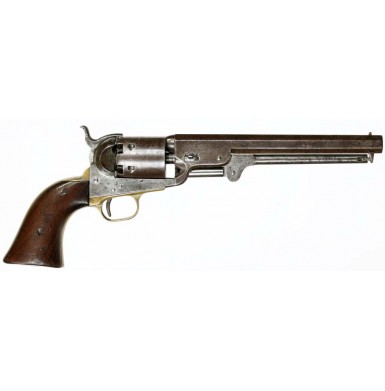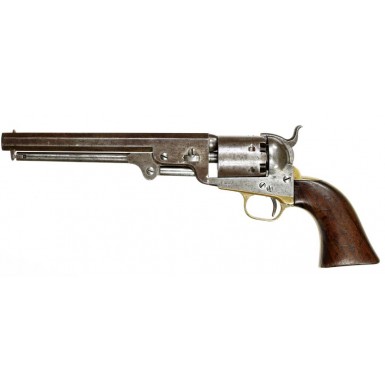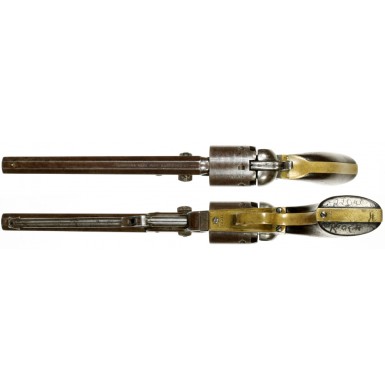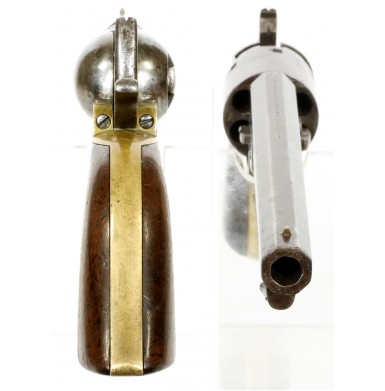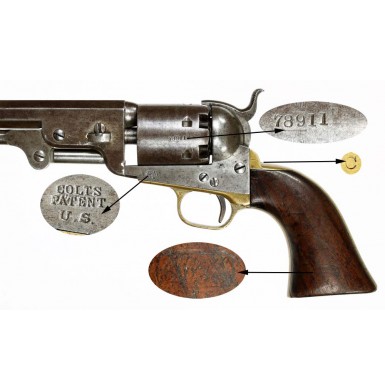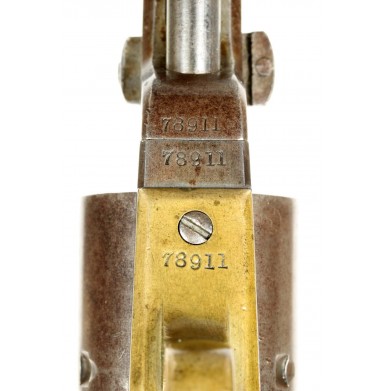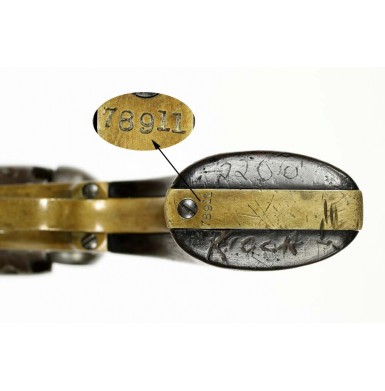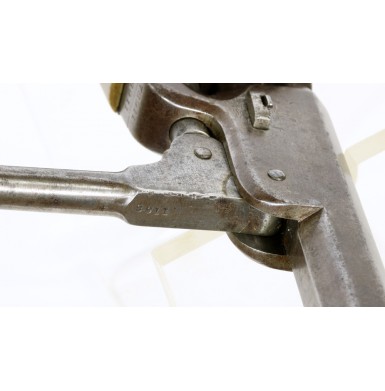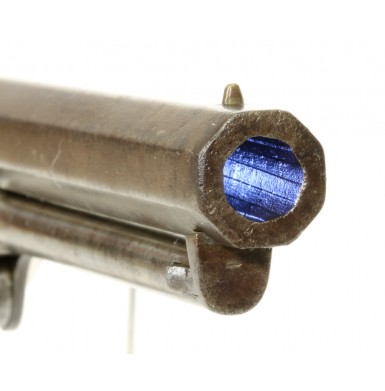Colt Navy-Army Martially Marked Model 1851 Revolver
- Product Code: FHG-3492-SOLD
- Availability: Out Of Stock
-
$3,795.00
In 1850 Samuel Colt introduced what would become his most successful large frame percussion revolver, a revolver that would be second only to his incredibly successful Model 1849 Pocket Model in sales of all percussion handguns. The Colt "Belt Model of Navy Caliber", better known to collectors as the Colt Model 1851 Navy Revolver went into production in 1850 and remained a mainstay of the Colt product line until 1873, when the it was finally dropped due to its obsolescence and low sales numbers when compared to self-contained cartridge revolvers. During that time Colt produced 215,348 of the pistols at his Hartford location and another 42,000+ at his short-lived London manufactory.
Colt was always trying to obtain military contracts for his firearms, as they not only represented sales, but also publicity and notoriety. Colt felt there was no better marketing message than to tell perspective customers that they could buy the same firearms used by the US government from him. The US Navy had been using Colt's Patent revolvers on a very limited basis since they first bought some No 5 Patterson Belt Model revolvers in 1841, and the US Army had acquired the Model 1847 "Walker" revolvers in 1847 for use by the Texas Rangers who had been absorbed into the US Mounted Rifles at the start of the Mexican American War. However, it was not until 1848 with the first contract for Colt's .44 Dragoon revolvers that the US Army started to acquire Colt revolvers in significant numbers. This is somewhat amazing in view of the fact that the Ordnance Department was notoriously conservative and ordering percussion revolvers only a decade after the adoption of a single shot flintlock pistol, the Model 1836, suggests that at least some of the officers were more forward thinking than we usually give them credit for. Over the next five years, nearly 7,000 .44 caliber Colt "Holster" pistols would be delivered to the Ordnance Department, most of which were Colt "Dragoon" models.
With the introduction of his new "Belt Model", Sam Colt immediately tried to get additional Ordnance Department contracts. In the fall of 1850, the Board of Ordnance convened to test the new Colt "Navy" model pistol. The handgun was significantly smaller than the Dragoon model and was almost half the weight, tipping the scales at only 2 pounds, 10 ounces, versus 4 pounds 2 ounces for the Dragoon. This explained Colt's name for the gun, the "Belt Model". This new smaller and lighter handgun could be carried in a belt worn holster, rather than in large pommel holsters necessary to support the much heavier Dragoon revolver. The gun was also a reduced caliber, at .36 instead of .44, giving it the effective stopping power of a modern .38 Special cartridge. This single factor convinced the Board of Ordnance to continue purchasing the larger and more powerful .44 caliber Dragoon pistols, at least for the time being.
The Navy was the first US service arm to decide to purchase the Model 1851 "Navy Caliber" revolver, as being able to carry a handgun on your belt was an important feature for sailors, who had little use for guns so massive that they required pommel holsters. The first 100 Colt "Navy-Navy" revolvers were delivered on July 10, 1852, and after a four-year hiatus purchases and deliveries of the revolvers continued with some regularity through September of 1859, when the purchases of 1851 Navy revolvers ceased. During that time 2,750 Model 1851 Navy revolvers were purchased.
The Navy's acceptance of the smaller "Navy" caliber revolver may have influenced the Army, as on 1 January 1855 an order was placed for the .36 Belt Revolvers. The first contract deliveries were made on May 2 of that year, with 500 revolvers being delivered. Over the next three years, Colt would deliver some 16,778 Model 1851 Navy revolvers to the US Army under at least 14 separate contracts. This number includes some revolvers ordered by the Ordnance Department for the states of Maine (6) and Ohio (60).
With the outbreak of the American Civil War, the Ordnance Department contracted for additional revolvers from Colt, but these were the primarily for the Model 1860 "Army" .44 caliber revolver and a small number of recently introduced New Model 1861 Navy revolvers. The Army did, however, procure some additional 8,117 Model 1851 Navy Revolvers on the open market from retailers like Schuyler, Hartley & Graham of New York and B. Kittredge & Company of Cincinnati, OH. These open market purchases are typically devoid of inspection or US ownership marks. However, the pre-Civil War Colt contract deliveries were stringently inspected and marked, and those guns not up to snuff were rejected. The martially marked "Navy-Army" revolvers were stamped U.S. on the lower left side of the frame, under the COLT'S / PATENT marking, and single sub-inspection letters were stamped on most of the major components of the revolvers. After passing the inspection process, the walnut grip then received two cartouches, the one on the left side being that of the arsenal sub-inspector who had passed the gun, and the one on the right side being the accepting officer from the Ordnance Department who was accepting the gun for the US government, and the bill associated with that gun.
The majority of the martially marked, pre-Civil War contract Model 1851 Navy revolvers are found in the serial number range from about 42,000 to about 80,000 placing their production between early 1855 (which started that year's production at about #40,000) and late 1857 (which ended that year's production around #85,000). The majority of the martially marked US Army "Navies" are 3rd Model revolvers with small brass triggerguards, a wide capping cut out in the recoil shield and a narrow lever catch. While the US Navy specifically requested iron backstraps and triggerguards for their Model 1851 revolvers, the Army accepted the standard brass backstraps and triggerguards on their guns. Many of the early Model 1851 Navies that were delivered to the Army were issued to the newly formed 1st and 2nd Cavalry regiments, who used them to good effect, fighting hostile natives on the western plains. Some 7,800 Colt Navy revolvers had been issued for use by troops in the field by the end of fiscal year 1859 (ending June 30 of that year). Additionally, some 2,000 were issued to the various states under the Militia Act of 1808, with the three largest batches going to Indiana (who receiving 250 in September 1857), New Hampshire (who received 300 in October 1857) and Texas (who receiving 368 in August 1858). Of course, the Model 1851 Navy-Armies remained in use during the American Civil War as well, with at least fifty-six US and volunteer regiments being armed with the .36 Colt revolvers. These included the 1st, 3rd, 4th & 6th US Cavalry, the 1st Arkansas Volunteer Cavalry, 9 regiments of Illinois Volunteer Cavalry (1st-3rd, 6th, 8th-11th & 13th), 1st-3rd & 10th Ohio Volunteer Cavalry, 6 regiments of Kansas Volunteer Cavalry (5th-7th, 9th, 11th & 15th), 6 regiments of Michigan Cavalry (1st-4th, 7th & 9th) and 5 regiments of New York Volunteer Cavalry (1st, 5th, 6th, 10th & 11th), just to name a few. Due to the fact that many of the pre-war purchased guns saw frontier duty before the Civil War, and most saw significant action during the war, it is difficult to find high condition, or even crisp and complete examples of a US martially marked "Navy-Army" revolvers today.
With the conclusion of the Civil War the M1851 Navy revolver was considered obsolete and removed from service, with the larger .44 Model 1860 Army being available in more than sufficient supplies to arm the much smaller, peacetime army. Many Colt Navy revolvers were purchased by the men who carried them and taken home after the war, with their cost being deducted from the trooper's pay. Additional revolvers were disposed of at auction, held at the various US government arsenals. The guns that had cost the government between $18 and $25 each prior to the war, and as much as double that on the open market during the war, were sold off for paltry sums. In May of 1870 113 Colt Navies were sold at Fort Leavenworth, KS for $346.00 (about $3.06 each) and another 112 were sold from the St. Louis Arsenal in June of 1871 for $3.05 each. The last sale that I could find records of was for 77 Colt Navies that sold for $3.15 each from the St. Louis Arsenal on October 25, 1876.
This is a really very nice example of a Colt Model 1851 "Navy-Army" percussion revolver in about VERY GOOD condition. The gun is a typical 3rd Model revolver with the small brass trigger guard, thin loading lever latch and large percussion capping cutout. As a martial revolver, it is correctly marked with sub-inspection letters, "US" ownership marks and inspection cartouches on the grips. The gun is serial numbered 78911, placing production in the latter portion of 1857. The revolver was probably part of the 13 May 1857 contract and was likely delivered by the end of 1857 or during the first quarter of 1858. The serial numbers match throughout, with even the wedge numbered and matching. The wedge, loading lever and cylinder arbor show only the last 4 digits of the number, 8911, while the balance of the numbered components have all five digits present. The one-piece walnut grip is ink numbered 8911 in the backstrap cut out, in a legible period hand. The revolver is crisply and clearly marked on the lower left side of the frame: COLT'S / PATENT / U.S., and with a small factory inspector's V on the front left web of the triggerguard. The face of the cylinder is stamped with a * between one of the chambers and the central hole for the arbor. This is a US government ownership mark. The gun shows multiple sub-inspection initials throughout out with an H and a M on the cylinder, a C on the grip strap and backstrap, and an S on the top of the barrel, at the end of the barrel address. The one-piece oiled walnut grip is cartouched on both sides. The right side bears a partially legible sub-inspector's cartouche in a rectangular cartouche with rounded edges that appears to be the script ADK of arsenal sub-inspector A.D. King. The right grip shows the oval cartouche with rounded ends of US Ordnance receiving officer William Anderson Thornton, and his script WAT remains crisp and clear. The top of the 7 ½” octagon barrel is clearly marked:
ADDRESS SAML COLT HARTFORD CT.
As noted, the gun is in about VERY GOOD condition overall, and for a martial Model 1851 Navy revolver it is really much better than most examples encountered today. The revolver retains none of its original blued finish. The overall, the gun has a mostly smooth, plum brown patina that is slightly mottled with areas of darker oxidization and discoloration. The casehardened frame has a mottled, smoky gray patina with areas of oxidized discoloration, which hints at the original mottled case colors. The barrel is free of any significant pitting, but there is some lightly oxidized freckling scattered along the barrel and some moderate pinpricking present on the face of the muzzle. The pistol shows the usual impact marks on the barrel web where the wedge had been beaten out of the pistol during its service life, and then beat back into place. Most of the marks are confined to the right side of the barrel. The bore of the revolver rates GOOD+ to NEAR VERY GOOD as well. The bore has a dark, oxidized patina but retains strong rifling its entire length. There is lightly scattered pitting the entire length of the bore, with a few scattered patches of more moderate pitting. The loading lever moves smoothly and operates correctly. It also locks tightly into place, as it should, when not in use. The cylinder retains none of its finish either, and has a slightly thinner, oxidized brown patina than the barrel. The cylinder retains only traces of the roll engraved naval battle scene between the Mexican and Texas navies. This is not uncommon, as regularly holstering and un-holstering the revolver tended to wear the thinly rolled scene, resulting in its disappearance over time. The cylinder is clearly marked with the serial number 78911, but the COLT'S PATENT No part of the marking is worn away. All of the safety pins on the rear face of the cylinder are battered, worn and essentially remain only as heavily worn lumps. The brass grip frame, grip strap and trigger guard show no silver-plating. As many of the Colt revolvers were delivered with "military finish", it was not uncommon for the silver plating of the brass to be omitted, the bluing to be a lower quality and lower polish than that found on civilian guns, and the grips to be oil finished instead of varnished. The action of the revolver remains excellent, and the gun functions correctly. The timing, indexing and lock up and excellent and the revolver remains very tightly. The action of the pistol remains quite crisp. All of the screws are original, and most are relatively crisp, showing only minor to moderate slot-wear. The original brass post front sight is in place on the top of the barrel, near the muzzle. The military style, one-piece oiled walnut grip is in about VERY GOOD condition. As noted, it is numbered to the revolver and fits the frame of the gun perfectly. The grip is free of any breaks, cracks, or repairs, and remains fairly crisp and sharp. The grip shows scattered light to moderate bumps and dings from handling and use. The only wood loss noted on the grip is the rounding of the sharp corners at the bottom leading and trialing edges where they show minute chips. As noted above, the grip shows a pair of partially legible inspection cartouches. The bottom of the grip is carved with the name Koch, possibly the name of the trooper who carried the gun. The name is deeply and somewhat crudely carved and certainly appears to be contemporary with the period of use. With more than 900 US soldiers and almost 40 CS soldiers with that last name who served during the war, it would be impossible to determine who this particular "Koch" was. The bottom of the grip is also scratched with the number 2200, the meaning of which is unknown.
Overall, this is a really nice, solid example of a pre-Civil War production, US military contract Colt Model 1851 Navy-Army. The gun is 100% complete, correct, and original in every way and revolver is correctly martially marked throughout. It is very attractive and displays quite nicely. The revolver has all matching serial numbers, is mechanically excellent, and retains nice markings. Pre-Civil War and Civil War era martial Colts are very difficult to find in this kind of solid, complete condition, as most saw heavy use in the years leading up to the Civil War and often even harder use during the war. After nearly a decade of constant military issue and use, and more than another 150 years since the war, few marital Colt Navy revolvers survive today in much better than "fair to good" condition. This one is fairly crisp, retains a nice, uncleaned patina and is very well marked for a martial revolver. If you only have one Colt Navy in your collection, a martially marked US Army issued Navy is a hard one to beat. I am quite sure that this will be one of those guns that you will be very happy to have in your collection. Of all the Civil War era handguns, the Colt Navy is probably the most representative example of what a common cavalryman on either side would have had access to, in terms of a "combat" handgun. It's no wonder that the Colt Navy was a favorite of cavalrymen both North and South and that so many Confederate-made revolvers were essentially copies of the Model 1851 Colt.
SOLD
Tags: Colt, Navy, Army, Martially, Marked, Model, 1851, Revolver


